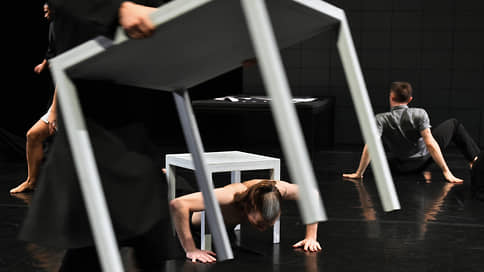Truth in the final instance – Newspaper Kommersant No. 182 (7383) dated 03.10.2022
[ad_1]

The former Meyerhold Center (now the Stage on Novoslobodskaya of the School of Dramatic Art) hosted the premiere of the play The Story of a Room directed by choreographer Artem Ignatiev, a company resident. This is the last project of Ballet Moscow: from November 1, a dance group with 30 years of experience will join the staff of the Novaya Opera Theater, retaining its own name, but losing its independence. Farewell to the last appreciates Tatyana Kuznetsova.
The “optimization” that has overtaken Moscow theaters in recent months at the behest of the Moscow Department of Culture has not bypassed dance troupes either. Ballet Moscow, a quite successful company that has existed for more than 30 years, will become a division of the Novaya Opera in a month. It is possible that in this case both parties to the merger will benefit, but it all depends on how exactly the creative policy of the troupe will be built. The fact is that Ballet Moscow, famous primarily for its exclusive international projects in the field of contemporary dance (all the Golden Masks were brought to it by work with foreign choreographers, including Alexander Pepelyaev, who has been working outside Russia for more than 20 years), as a result of the events after At the beginning of the special operation, he lost not only the opportunity to invite directors from abroad, but also his leader: the director of the troupe, the smart and resourceful manager Elena Tupyseva, who knew the world choreographic market perfectly, did not renew her contract. The company remained in the care of its resident choreographer Artem Ignatiev, who has been on the staff of Ballet Moscow since 2013. Since then, he (in collaboration with Anastasia Kadruleva) has staged a dozen performances, but none of them has proved competitive.
“The Story of a Room” became his thirteenth attempt to establish himself in the ranks of choreographers-newsmakers, albeit domestic ones. As an ally, he (the indispensable Anastasia Kadruleva is listed as a co-author in the program) attracted Vasily Peshkov, an electronics composer who over the past four years has become almost the most sought-after author of the plastic theater – a sort of Ludwig Minkus under Marius Petipa. Keeping a balance between inferno and general accessibility, alternating between meditativeness and exuberant beats, specific noises and melodism, the composer Peshkov is able to satisfy the demand of any choreographer. In The Story of a Room, the numbering principle of his compositions was especially useful – Artem Ignatiev monitors the contrast of his miniatures, enclosed in an open black space. Scenographer Pavel Ivashkin built a “room” of two white tiled walls, furnishing it with a white table and chair, a black box (upright, it can serve as a closet) and a black ottoman covered with spotted bristly skin. The lantern on the left of the proscenium, in all likelihood, is intended to indicate an exit outside the room – “an allegorical image of non-existence and constant timelessness”, as the choreographer himself certifies the stage space.
In this “image of non-existence” the characters of the play “define the vector of their existence” in a very specific way. For example, the soloist in a black blind blouse and breeches skirt, who opens a series of episodes and is called the Cleaning Lady in the program, wipes accessible surfaces with her body and moves furniture – sadly, but purposefully. Another soloist, wearing stiletto heels, in a mini dress with an open back and a school white collar, simply called Woman, throws batmans and spreads her legs in second position, seducing everyone, including the audience. The pas de quatre, during which three men toss, break and drag the pliable Woman like a rubber doll, should probably serve as a pamphlet against sexual exploitation, but it must be admitted that the victim’s behavior was provocative. The “vector of existence” of a married couple is obvious: she loves him, he does not love her. It is more difficult with the “allegorical image” of the soloist, grieving at the coffin-box, from which the “dead man” rises in the finale of the performance: it seems that the author himself did not solve the problem, immediately after that he turned off the light and did not allow the character to react to the revived allegory.
The program, which warned that each character “either tragically dies or conquers space, knowing the truth,” deceived: in addition to the person who played the box, only one died, and then on the “street”. He walked to the lantern, artlessly opening his arms to the sides (this is how Christ is usually depicted in ballets), and was stabbed to death by two villains. The remaining 13 participants in the events, apparently, “knew the truth” in a general motor synchronized dance of a somewhat macabre nature, at the end of which they disappeared one by one, leaking into the cracks behind the cabinet and under the couch.
A long list of events does not mean that the performance is entertaining. “The story of one room” is predictable at all levels – from individual movements and combinations to the overall composition, essentially divertissement. The choreographer’s servile readiness to entertain the audience without sacrificing homegrown philosophy leads to the opposite result: “The Story of a Room” is frankly boring, despite the fact that the performers are young, plastic, have good physical abilities and work with enthusiasm. The problem, of course, is in the choreographer, from whom it is not even talent that is required, but a simple handicraft ability to set sane tasks – formal, bodily, conceptual – and consistently solve them. But in Russia, where dance is a movement of the spirit and “knowledge of the truth,” this is not taught.
[ad_2]
Source link






